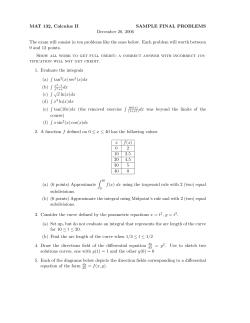
Laboratory 4. First Order Nonlinear Differential Equations 1. We
Universitatea Babe¸s-Bolyai, Facultatea de Matematic˘a ¸si Informatic˘a Sect¸ia: Informatic˘ a englez˘ a, Curs: Dynamical Systems, An: 2014/2015 Laboratory 4. First Order Nonlinear Differential Equations 1. We consider x0 = 1 − x2 . a) Find its constant solutions. b) Find the solution φ(t, η) of this differential equation that satisfies x(0) = η, where η ∈ R is fixed. Denote it with φ(t, η). Notice that φ(t, 1) = 1 and φ(t, −1) = −1 but the formula returned by Maple for φ(t, η) after using the command dsolve is not defined neither for η = 1 nor for η = −1. c) Represent simultaneously various integral curves of this differential equation. For better results represent first for initial values η ∈ (−1, 1). Then for initial values η > 1 but very close to 1, and for positive values of t (on the interval (0, 2), for example). Then for initial values η < −1 but very close to −1, and for negative values of t (on the interval (−2, 0), for example). d) Study the validity of the proposition ”Each nonconstant solution is strictly monotone.” e) Study the validity of lim φ(t, η) = 1 for all η > −1. t→∞ 2. Find the general solution of x0 = 1 − tx3 . Set infolevel[dsolve] to 3 to see what is going on. So, there is no algorithm available to Maple to find its general solution. Not even for writing it in terms of some special functions. Using dfieldplot represent the corresponding direction field. Using DEplot represent the numerical solution that satisfies, for example x(0) = 0. Add other initial conditions to represent more numerical solutions simultaneously. 3. Using dfieldplot represent the direction field in a box that contains the origin, for each of the differential equations. We know that these directions are tangent to the integral curves. What kind of curves could be the integral curves of each differential equation? Find the general solution of each differential equation and see if your intuition is confirmed. Remember that y = mx is the equation of a line, xy = a is the equation of a hyperbola, x2 + y 2 = r2 is the equation of a circle, while a2 x2 + b2 y 2 = 1 is the equation of an ellipse. −x −2x a) y 0 (x) = y(x) ; b) y 0 (x) = − y(x) ; c) y 0 (x) = y(x) ; d) y 0 (x) = y(x) . x x 1 2 4. Using contourplot find the level curves in a box that contains the origin of the scalar functions of two variables H1 (x, y) = xy, H2 (x, y) = x2 + y 2 and, respectively, H3 (x, y) = 2x2 + y 2 . Relate these with the previous exercise. Notice that the differential d equation found performing the calculations in dx H(x, y(x)) = 0, is the equation whose integral curves are the level curves of H. Find in this way the corresponding differential equation for each function H1 , H2 , H3 written above. 5. Find the differential equation whose integral curves are the level curves of H(x, y) = x2 + 4y 2 . 6. Represent the level curves of H(x, y) = y 2 − cos x origin. Notice that the level curves are closed. in a box that contains the
© Copyright 2025








